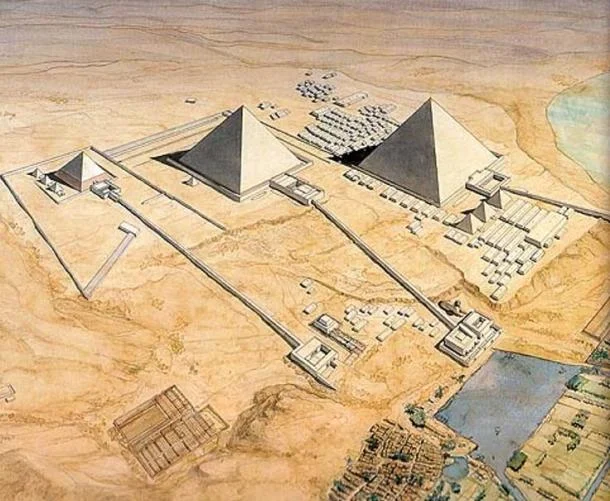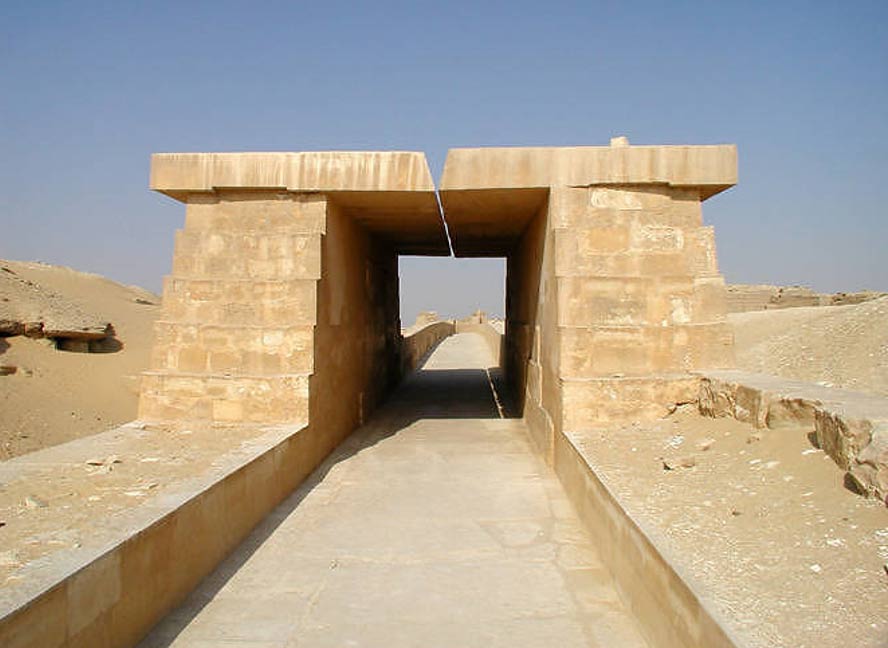The causeway ends at the elevation of the Pyramid in a Temple that abuts the enclosing wall of the Pyramid. This form of temple can be seen in the artist’s recreation for the three Great Pyramids of Giza shown in Figure 2. They can be seen to the lower right hand side of each of the Pyramids. This temple provided the access point into the walled enclosure and the pyramids.
Little needs to be said about the pyramid proper of each of the complexes. They are large and eye catching and have received much interest from modern day explorers. From the perspective of an initiate intent on incubation, they form isolated spaces comparable to the often-used caves that continue to be used for meditation by initiates in modern day traditions. Although rough sarcophagi have often been found within the Old Kingdom pyramids there is scant evidence of human remains. Also missing from the pyramids are mummies and all the many other funerary objects typically found in the numerous dedicated tombs of Ancient Egypt. But the suggestion of an initiation ceremony taking place within the isolated confines of the pyramid proper made by Brind Morrow[11] could be the key to their construction.
We have been most impressed with the works of Jeremy Naydler[12] & [13], and more recently Susan Brind Morrow[14] and their findings that the first pyramids, and their carved texts, were designed as special venues for the development of higher Being. The Pyramid Texts are a collection of recitations written in Egyptian hieroglyphs in eleven of the earliest Old Kingdom pyramids built ca. 2400–2300 BCE. The texts are engraved on the walls, ceilings and surfaces of the internal cavities. They are the very first fully coherent literature recorded by humans. They describe the journey of an individual through a world quite different from our ordinary day-to-day world. The Ancient Egyptian name for this “Netherworld” is the Duat[15]. Naydler in his work makes the important point that the Pyramid Texts are intended for readers that are alive[16]. He sees the texts as aids for an initiate who is in the process of reaching for higher levels of Being – that is, someone striving to reaching the level of gods in the stars.
One translation reads Recitation 44 from the Pyramid Texts of Pepi I as:
“Pepi has gone to be with his ka.
Ho, Pepi! You have gone away that you might live; you have not gone away that you might die.
You have gone away that you might become akh at the fore of the akhs, take control at the fore of the living, become ba and be ba, become esteemed and be esteemed.[17]"
How can we envisage the experience of the Pharaoh or initiate. A ritualistic procession of the Pharaonic initiate from the edge of the Nile through the Valley Temple up an enclosed darkened passage built on a man-made causeway to the pyramid may have ended in quiet incubation in the stillness of the inside of their pyramid. Only after passing through these structures would entrance into the pyramid proper and its marvellous Pyramid Texts be accessed. There one would be surrounded by the finely embossed hieroglyphs - thus to be literally surrounded by the Pyramid Texts. It is certain that each of these elements of the Pyramid Complex played an important role in the overall function and use of the pyramids. It is easy to envisage this physical journey of the initiate as embodying a metaphysical journey the soul through the Duat.
It is not difficult to imagine the term initiation or “incubation[18]” as applying to what was experienced by the Pharaohs and initiates of Old Kingdom Egypt in the dark stillness inside the Pyramids. We the authors, having personally experienced the stillness of the King’s Chamber in the Great Pyramid of Khufu on visits to Egypt and can testify that it is certainly a place of isolation from the rest of the world and calls us to appreciate that mysteries still exist and can be sensed by us. The Pyramid Complexes formed an important venue for the initiation rites of the Pharaoh. A journey beyond ordinary life, through the Duat, that is the Egyptian netherworld, must have been taken by Pharaohs who were trained for the journey of their spirit through to the high place of the sun, Ra, and back to this world to exist as a star for their people in their lifetime. Pyramid Complexes were likely key to such exposure to their higher Being.
[1] Malkowski, E.F. 2010. Ancient Egypt 39,000 BCE The History, Technology, and Philosophy of Civilization X. Inner Traditions.
[2] https://en.wikipedia.org/wiki/Orion_correlation_theory
[3] Hale, R., & Collins, A. 2016. A Study of the Simple Geometrical Relationship of the Main Monuments of Giza and a Possible Connection to Stars. Archaeological Discovery, 4, 87-102. http://dx.doi.org/10.4236/ad.2016.42007
[4] http://awhico.com/blog/2015/4/14/milky-way-symbolism
[5] https://en.wikipedia.org/wiki/Unas
[6] Hale, R., & Collins, A. 2016. A Study of the Simple Geometrical Relationship of the Main Monuments of Giza and a Possible Connection to Stars. Archaeological Discovery, 4, 87-102. http://dx.doi.org/10.4236/ad.2016.42007.
[7] http://www.ancient-origins.net/news-history-archaeology/after-decades-searching-causeway-great-pyramid-egypt-has-been-found-002530
[8] https://en.wikipedia.org/wiki/Egyptian_temple
[9] West, John Anthony. 1985. The Traveller’s Key to Ancient Egypt: A Guide to the Sacred Places of Ancient Egypt. Quest Books.
[10] https://commons.wikimedia.org/wiki/File:01_unas_causeway.jpg
[11] Brind Morrow, S. 2015. The Dawning Moon of the Mind. Farrar, Straus and Giroux. New York.
[12] Naydler, J. 1996. Temple of the Cosmos: The Ancient Egyptian Experience of the Sacred. Inner Traditions.
[13] Naydler, J. 2004. Shamanic Wisdom in the Pyramid Texts: The Mystical Tradition of Ancient Egypt. Inner Traditions.
[14] Brind Morrow, S. 2015. The Dawning Moon of the Mind: Unlocking the Pyramid Texts. Farrar, Straus and Giroux. New York. 289 pp.
[15] Dickie, L.M and P.R. Boudreau. 2015. Awakening Higher Consciousness: Guidance from Ancient Egypt and Sumer. Inner Traditions.
[16] Naydler, J. 2004. Shamanic Wisdom in the Pyramid Texts: The Mystical Tradition of Ancient Egypt. Inner Traditions.
[17] Allen, J.P., 2005. The Ancient Egyptian Pyramid Texts. Society of Biblical Literature. page 108.
[18] Kingsley, P. 2003. Reality. The Golden Sufi Centre Publishing. Inverness, California.










